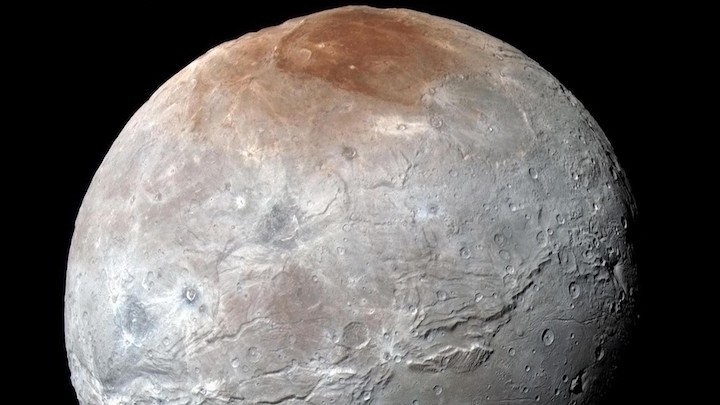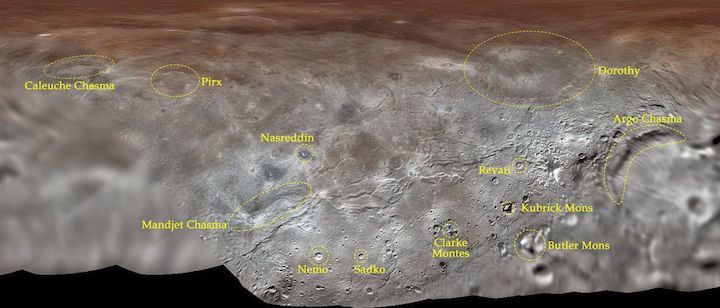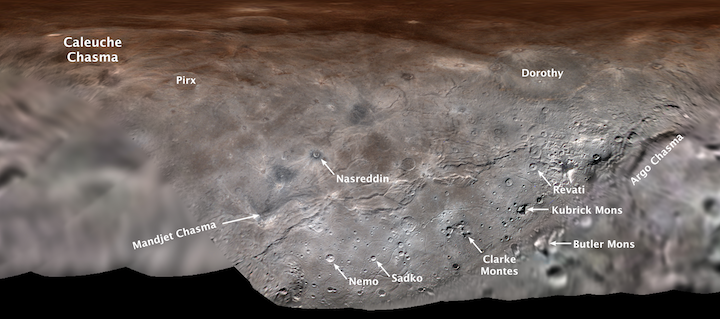12.04.2018

Space nerds and science fiction fans, rejoice! Some of the craters, mountains, and other features of Pluto's largest moon Charon just got official names, and they're nerdy as hell.
From a mountain named after Stanley Kubrick to a crater named for Captain Nemo, many of Charon's features have now been named for the "literature and mythology of exploration," according to the International Astronomical Union (IAU), the organization responsible for assigning such monikers.
Have you ever wanted to visit a mountain named for Octavia Butler? Well, take a trip to Charon and visit Butler Mons to honor the science fiction writer and her Xenogenesis trilogy.

The IAU also named a crater for Revati, the protagonist of the Mahabharata, and a crater for Sadko, an ocean explorer in the Russian story Bylina, the IAU explained in a statement.
“I am pleased that the features on Charon have been named with international spirit," The IAU's Rita Schulz, said in the statement.
Other IAU-approved names include:
Argo Chasma is named for the ship sailed by Jason and the Argonauts, in the epic Latin poem Argonautica, during their quest for the Golden Fleece.
Caleuche Chasma is named for the mythological ghost ship that travels the seas around the small island of Chiloé, off the coast of Chile; according to legend, the Caleuche explores the coastline collecting the dead, who then live aboard it forever.
Clarke Montes honours Sir Arthur C. Clarke, the prolific science fiction writer and futurist whose novels and short stories (including 2001: A Space Odyssey) were imaginative depictions of space exploration.
Dorothy Crater recognizes the protagonist in the series of children’s novels, by L. Frank Baum, that follows Dorothy Gale’s travels to and adventures in the magical world of Oz.
Mandjet Chasma is named for one of the boats in Egyptian mythology that carried the sun god Ra (Re) across the sky each day — making it one of the earliest mythological examples of a vessel of space travel.
Nasreddin Crater is named for the protagonist in thousands of humorous folktales told throughout the Middle East, southern Europe and parts of Asia.
Pirx Crater is named for the main character in a series of short stories by Stanislaw Lem, who travels between the Earth, Moon, and Mars.
The IAU picks names for cosmic objects and their features by using naming conventions established for each world explored.
Pluto's features, for example, need to be named for mythologies of the underworld, writers who have used Pluto in their world, and scientists germaine to the exploration of the small world, according to NASA. Charon's naming convention centers on fictional exploration.
Some of the official names for Charon's features were chosen from a batch provided by the OurPluto campaign, which asked space fans on the internet to submit possible names for features on Pluto and its moons for NASA's New Horizons mission.
New Horizons — which made its flyby of Pluto in 2015 — marked the first time that humanity got a chance to see the world in distant space from close range.
Quelle: Mashable
+++
Pluto's Largest Moon Gets Its First Official Feature Names
Legendary explorers and visionaries, real and fictitious, are among those immortalized in the first set of official surface-feature names for Pluto's largest moon, Charon.
The International Astronomical Union (IAU), the internationally recognized authority for naming celestial bodies and their surface features, recently approved a dozen names proposed by NASA's New Horizons mission team, which led the first reconnaissance of Pluto and its moons (by the New Horizons spacecraft) in 2015. The New Horizons science team had been using some of the chosen names informally to describe the many valleys, crevices and craters discovered during that first close-up look at Charon's surface.
"Charon is among the 10 largest bodies in the Kuiper Belt, a world unto itself, with a fascinating geological history and many kinds of geological features beyond the craters seen on most moons," said Alan Stern, New Horizons principal investigator from Southwest Research Institute, Boulder, Colorado. "Now those features, and some of Charon's most important craters, have official names."
In moving the names through approval, Stern lauded the work of the New Horizons Nomenclature Working Group, which along with Stern included science team members Mark Showalter – the group's chairman and liaison to the IAU – Ross Beyer, Will Grundy, William McKinnon, Jeff Moore, Cathy Olkin, Paul Schenk and Amanda Zangari. The team gathered most of their ideas during the "Our Pluto" (http://www.ourpluto.org) online public naming campaign in 2015.
"The names reflect the diversity of recommendations we received during the Our Pluto campaign," noted Showalter, a senior research scientist at the SETI Institute in Mountain View, California. "We are delighted that so many people from all over the world have contributed to the new names on the map of Charon."
Many of the feature names in the Pluto system pay homage to the spirit of human exploration, honoring travelers, explorers and scientists, pioneering journeys, and mysterious destinations. The approved Charon names focus on the literature and mythology of exploration. They are listed here:
Argo Chasma is named for the ship sailed by Jason and the Argonauts, in the epic Latin poem Argonautica, during their quest for the Golden Fleece.
Butler Mons honors Octavia E. Butler, the first science fiction writer to win a MacArthur fellowship, and whose Xenogenesis trilogy describes humankind's departure from Earth and subsequent return.
Caleuche Chasma is named for the mythological ghost ship that travels the seas around the small island of Chiloé, off the coast of Chile; according to legend the Caleuche explores the coastline collecting the dead, who then live aboard it forever.
Clarke Montes honors Sir Arthur C. Clarke, the prolific science fiction writer and futurist whose novels and short stories (including "2001: A Space Odyssey") were imaginative depictions of space exploration.
Dorothy Crater recognizes the protagonist in the series of children's novels, by L. Frank Baum, that follows Dorothy Gale's travels to and adventures in the magical world of Oz.
Kubrick Mons honors film director Stanley Kubrick, whose iconic "2001: A Space Odyssey" tells the story of humanity's evolution from tool-using hominids to space explorers and beyond.
Mandjet Chasma is named for one of the boats in Egyptian mythology that carried the sun god Ra (Re) across the sky each day – making it one of the earliest mythological examples of a vessel of space travel.
Nasreddin Crater is named for the protagonist in thousands of humorous folktales told throughout the Middle East, southern Europe and parts of Asia.
Nemo Crater is named for the captain of the Nautilus, the submarine in Jules Verne's novels Twenty Thousand Leagues Under the Sea (1870) and The Mysterious Island (1874).
Pirx Crater is named for the main character in a series of short stories by Stanislaw Lem, who travels between the Earth, Moon and Mars.
Revati Crater is named for the main character in the Hindu epic narrative Mahabharata -- widely regarded as the first in history (circa 400 BC) to include the concept of time travel.
Sadko Crater recognizes the adventurer who traveled to the bottom of the sea in the medieval Russian epic Bylina.

Map projection of Charon, the largest of Pluto's five moons, annotated with its first set of official feature names. With a diameter of about 755 miles, the Texas-sized moon is one of largest known objects in the Kuiper Belt, the region of icy, rocky bodies beyond Neptune. (Credit: NASA/Johns Hopkins University Applied Physics Laboratory/Southwest Research Institute)
The New Horizons spacecraft is currently 3.83 billion miles (6.16 billion kilometers) from Earth, speeding toward a New Year's Day 2019 encounter with "Ultima Thule," a Kuiper Belt object orbiting a billion miles (about 1.6 billion kilometers) beyond Pluto. The centerpiece of New Horizons' extended mission through the Kuiper Belt, the Ultima flyby will be the farthest planetary encounter – with the most primitive object ever encountered – in spaceflight history.
Quelle: NASA
